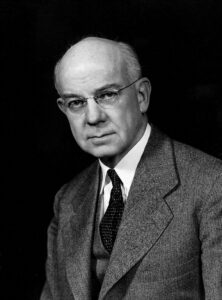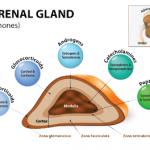
Dr. Kendall
With input from Dr. Kendall, the pharmaceutical company Merck eventually developed a complicated 37-step synthesis process to synthesize compound E (i.e., 17-hydroxy-11-dehydrocorticosterone; cortisone) in 1948, at great expense. In September of that year, Drs. Hench and Kendall requested some compound E from Merck to be given to an initial patient with RA: Merck eventually sent 5 g.3
Dr. Hench and colleagues began administering the compound to Mrs. G, a 29-year-old patient with severe RA. She had come to Mayo to receive Hench’s jaundice-inducing treatment, but when this hadn’t worked, she refused to leave without further treatment; instead, her determination became a part of medical history.3
Compound E in 14 RA Patients
In their report published in 1949, Drs. Hench, Kendall and colleagues described Mrs. G’s transformative response to compound E, after being given 100 mg total daily via intragluteal injections:1
When she awoke [two days after her initial injection] she rolled over in bed with ease and noted much less muscular soreness. [The next day] painful morning stiffness was entirely gone. Scarcely able to walk three days previously, the patient now walked with only a slight limp… A week after the administration of compound E was begun, articular as well as muscular stiffness had almost completely disappeared, and tenderness and pain on movement, and even swellings, were markedly lessened.
Drs. Hench and Kendall also described in detail the response to compound E of 13 additional patients with moderately severe or severe polyarticular arthritis, who also experienced near miraculous transformations in response to the drug.
Study Methods
Drs. Hench and Kendall elaborated on their study methods, side effect profile, dose-effect response and laboratory effects, such as sedimentation rate. They also described the effect of pituitary adrenocorticotropic hormone, which stimulates the production of multiple adrenal hormones, on two additional RA patients. This yielded similar therapeutic responses.1
“What really impressed me about the study was how carefully it was performed and reported, given our current perspectives,” notes Dr. Bucala. “Much less was then known about RA, but [Hench & Kendall] did some interesting things that are still more or less state-of-the-art in clinical investigation today.”
For example, Dr. Bucala highlights the use of the Westergren sedimentation rate as a marker of inflammation: The team saw that with the administration of compound E, the biomarker changed this blood test in predictable ways to indicate alleviation of the underlying disease. They also examined hemoglobin levels, a very sensitive marker of chronic inflammation, and showed decreased anemia of inflammation with treatment.

